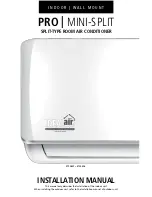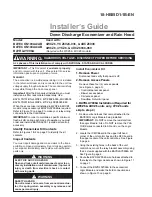
32
Installation (Continued)
Gas Heat Units (SFH_)
All internal gas piping is factory-installed and pressure leak-
tested before shipment. Once the unit is set into place, the
gas supply line must be field-connected to the elbow lo-
cated inside the gas heat control compartments.
WARNING
Hazardous Gases and Flammable Vapors!
Exposure to hazardous gases from fuel substances
have been shown to cause cancer, birth defects or
other reproductive harm. Improper installation, adjust-
ment, alteration, service or use of this product could
cause flammable mixtures. To avoid hazardous gases
and flammable vapors follow proper installation and set
up of this product and all warnings as provided in this
manual. Failure to follow all instructions could result in
death or serious injury.
When using dry nitrogen cylinders for pressurizing
units for leak testing, always provide a pressure regula-
tor on the cylinder to prevent excessively high unit
pressures. Never pressurize unit above the maximum
recommended unit test pressure as specified in appli-
cable unit literature. Failure to properly regulate pres-
sure could result in a violent explosion, which could re-
sult in death or serious injury or equipment or prop-
erty-only-damage. (add when appropriate: See maxi-
mum recommended unit test pressure below.)
Access holes are provided on the unit as illustrated in Fig-
ure 3-2B to accomodate a side or bottom pipe entry on 20
through 75 Ton units and Figure 3-2C for bottom entry on
90 through 130 Ton units. Following the guidelines listed
below will enhance both the installation and operation of the
furnace.
Note: In the absence of local codes, the installation
must conform with the American National Standard
Z223-1a of the National Fuel Gas Code, (latest
edition).
1. To assure sufficient gas pressure at the unit, use Table 3-
4 as a guide to determine the appropriate gas pipe size
for the unit heating capacity listed on the unit's name-
plate.
2. If a gas line already exist, verify that it is sized large
enough to handle the additional furnace capacity before
connecting to it.
3. Take all branch piping from any main gas line from the
top at 90 degrees or at 45 degrees to prevent moisture
from being drawn in with the gas.
4. Ensure that all piping connections are adequately coated
with joint sealant and properly tightened. Use a piping
compound that is resistant to liquid petroleum gases.
5. Provide a drip leg near the unit.
6. Install a pressure regulator at the unit that is adequate to
maintain 7" w.c. for natural gas while the furnace is oper-
ating at full capacity.
Note: Gas pressure in excess of 14" w.c. or 0.5 psig
will damage the gas train.
Failure to use a pressure regulating device will result in in-
correct gas pressure. This can cause erratic operation due
to gas pressure fluctuations as well as damage the gas
valve.
Over sizing the regulator will cause irregular pulsating flame
patterns, burner rumble, potential flame outages, and pos-
sible gas valve damage.
If a single pressure regulator serves more than one rooftop
unit, it must be sized to ensure that the inlet gas pressure
does not fall below 7" w.c. with all the furnaces operating at
full capacity. The gas pressure must not exceed 14" w.c.
when the furnaces are off.
7. Provide adequate support for all field installed gas piping
to avoid stressing the gas train and controls.
8. Leak test the gas supply line using a soap-and-water so-
lution or equivalent before connecting it to the gas train.
9. Check the supply pressure before connecting it to the
unit to prevent possible gas valve damage and the un-
safe operating conditions that will result.
Note: Do not rely on the gas train shutoff valves to
isolate the unit while conducting gas pressure/leak
test. These valves are not designed to withstand
pressures in excess of 14" w.c. or 0.5 psig.
Connecting the Gas Supply Line to the Furnace Gas
Train
Follow the steps below to complete the installation between
the supply gas line and the furnace. Refer to Figure 3-10 for
the appropriate gas train configuration.
1. Connect the supply gas piping using a "ground-joint" type
union to the furnace gas train and check for leaks.
2. Adjust the inlet supply pressure to the recommended 7"
to 14" w.c. parameter for natural gas.
3. Ensure that the piping is adequately supported to avoid
gas train stress.
Содержание INTELLIPAK RT-SVX10C-EN
Страница 16: ...15 Figure 3 1 Minimum Operation and Service Clearances for Single Multiple Unit Installation...
Страница 17: ...16 Figure 3 2A SAHF Cooling Only Units 20 thru 75 Ton...
Страница 19: ...18 Figure 3 2B SEHF SFHF SLHF SSHF SXHF Units 20 thru 75 Ton...
Страница 21: ...20 Figure 3 2C S_HG Cooling Heating Units 90 through 130 Ton...
Страница 25: ...24 Figure 3 4 Typical Unit Rigging Figure 3 5 Unit Base Roof Curb Section...
Страница 38: ...37 Figure 3 13 Steam Coil Piping 20 through 30 Ton Units Steam Coil Piping 40 through 130 Ton Units...
Страница 41: ...40 Figure 3 14 Continued Typical Field Power Wiring 90 thru 130 Ton Table 3 6 Customer Connection Wire Range...
Страница 52: ...51 Field Connection Diagram Notes for 20 through 130 Ton CV or VAV Applications...
Страница 86: ...84 Figure 4 6 Compressor Locations...
Страница 103: ...101 Service Maintenance Continued Table 5 3 Unit Internal Fuse Replacement Data VFD Factory Settings...
Страница 117: ...115...
Страница 118: ...116...
















































